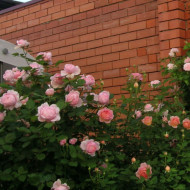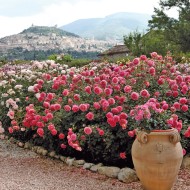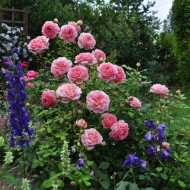Description of the English rose Jubilee Celebration: reviews of gardeners
Content
Origin story
The English park rose Jubilee Celebration has an interesting origin story. The author of the flower is the world famous breeder and enthusiast David Austin. A breeding experiment to develop a new variety began in 1998. 4 years later - in 2002 - David Austin presented an elegant flower with old domed buds for everyone to see. The bush rose got its name in honor of the golden anniversary of Queen Elizabeth II of England.
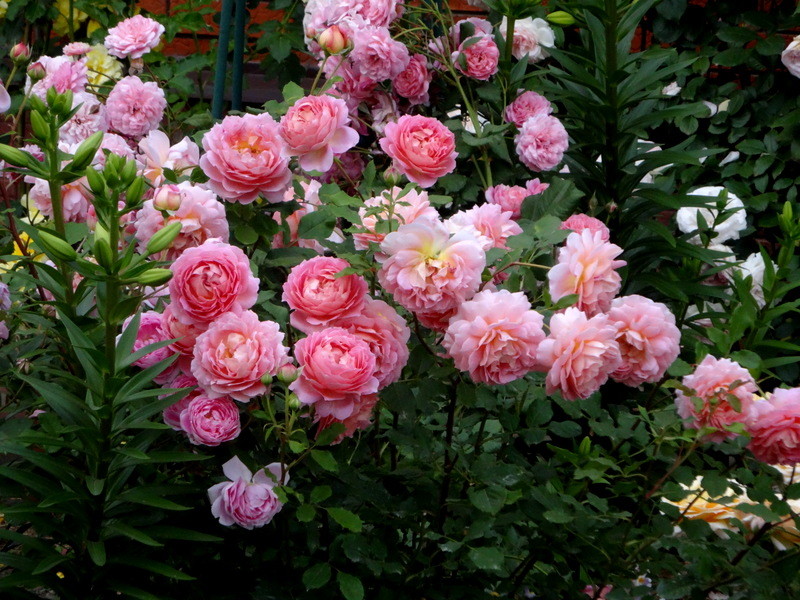
Description and characteristics of rose Jubilee Celebration
Park rose Jubilee Celebration is prone to intensive growth and development. During the growing season, the shoots of the spreading shrub take an arched shape. The average height of a bush rose is 120 cm, its width is also 120 cm. The leaves of the variety have an elliptically pointed shape and a dark green color. The outer side of the sheet is characterized by a traditional glossy sheen.
The buds are large, old-fashioned dome-shaped, deep pink with a pale salmon tint. As flowering progresses, there is a slight burnout of the petals. The diameter of the calyx of the opened bud reaches 12-14 cm. The variety has a pronounced aroma. The fragrance of young flowers is similar to the fresh, slightly bitter scent of lemon peel. Gradually, fruity, berry and mint notes appear in the scent.
The first buds bloom towards the end of spring. The rose bush blooms until the first autumn frosts. The originator declared two waves of flowering. However, experienced gardeners claim that Jubilee Celebration has three waves of active and continuous flowering.
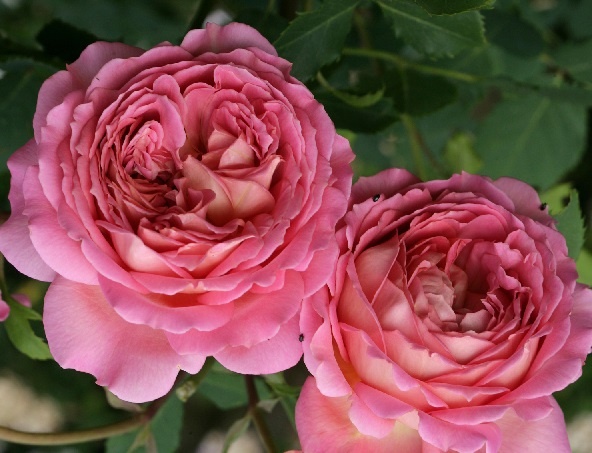
Advantages and disadvantages of the variety
Unfortunately, the Jubilee Celebration rose has both positive and negative qualities. Studying the pros and cons of the variety will help you choose the most correct scheme for the agricultural technology of ornamental culture.
- high decorative qualities of a rose bush;
- spectacular appearance and interesting color of buds;
- interesting, mutable aroma;
- abundant and almost continuous flowering;
- high resistance to invasions of pink aphids, caterpillars and other pests.
- high sensitivity of buds to dampness and rain (flowers droop or fall off);
- weakness of shoots in the first year after planting in a permanent place of growth;
- burnout tendency;
- the possibility of freezing during sudden temperature jumps;
- low immunity to black spot.
Video "English rose Jubilee Celebration"
This video shows the decorative and varietal qualities of the culture.
Features of agricultural technology rose Jubilee Celebration
Rose Jubilee Celebration is unpretentious in care - even beginner gardeners can cope with the cultivation of a crop.Consider the basic rules of agricultural technology of this variety.
Where and how to plant
For planting a bush rose with a spectacular appearance, the most viewed area of the garden is selected in order to be able to constantly admire the plant.
The rose is afraid of wind, draft and cold air stagnation. For this reason, ornamental crops should not be grown in lowlands and wind-blown slopes. The best option is planting near fences, garden pavilions and other plants.
Jubilee Celebration prefers light, breathable, fertile soil with an acidity ranging from pH 5.6 to 6.5. In too light sandy soil, clay, sod land and peat-manure compost are added. In turn, a mixture of river sand, peat and compost will help to increase the looseness of clay soil.
Planting a seedling in open ground is carried out in the spring - in April or May. The finished planting pit is laid out with expanded clay and broken brick. Then a layer of organic fertilizers is applied. When planting, make sure that the root collar deepens by 3-4 cm. At the end of planting work, watering and mulching of the shrub is carried out.

Care rules
In dry and warm weather, the rose bush is watered 2-3 times a week. One plant requires at least 15–20 liters of settled water. Watering is performed along the edge of the trunk circle, trying to prevent the soil from washing out near the roots. Towards the end of summer, the interval between waterings is increased.
If the summer has turned out to be generous in rainfall, you need to water the Jubilee Celebration rose as the topsoil dries out.
After each moistening of the soil, loosening is carried out. The loosened soil allows oxygen to pass through well, which is necessary for the root system for growth and development.
The rosebush is pruned in the spring. Moderate to medium pruning is suitable for Jubilee Celebration, which promotes early flowering and an increase in the decorative effect of the crop. All shoots - flowering and non-flowering - are cut to 5-7 buds. In order to prevent infection with infections, the cut sites are treated with garden varnish.

Jubilee Celebration rose should be covered for the winter. Horticultural crops are afraid of sudden temperature jumps. To insulate the shrub, pine spruce branches are used, on top of which burlap or agrofibre is fixed. Do not forget to plentifully mulch the root part of the plant with peat and dry opal foliage beforehand.
Diseases and pests
Jubilee Celebration has good resistance to diseases and pests typical of rose bushes. However, if agricultural technology is violated, the plant is attacked by a spider mite. To protect the ornamental shrub, infusion of garlic, a decoction of onion husks or preparations of insectoacaricidal action are used: "Appolo", "Nissoran", "Fufanon", "Iskra".
A common disease of the variety is black spot. The characteristic signs of pathology are dark spots on the leaf plates. Such fungicides will help to fight the disease: "Previkur", "Skor", "Topaz", "Fundazol" and "Abiga-Peak".
Rose Jubilee Celebration in Landscape Design
A graceful and aristocratic bush rose looks great in solitary plantings. Can be grown on a stem or as a hedge.
The flower is suitable for group plantings. The most successful neighboring crops are evergreens, conifers and cereals, since soft pink buds are in perfect harmony with green foliage and coniferous branches. The park rose is often used to decorate mixborders in landscape styles of English landscape, country and exquisite modern.
- Decoration of the site and buildings on its territory
- Growing on a trunk
- Rose garden with decorative elements
- Flower bed
Variety reviews
“Last summer, the Jubilee Celebration rose cultivated in our garden fell victim to an invasion of rose aphids. Insecticide "Actellik" helped to get rid of pests. The areas affected by insects had to be removed. Fortunately, the bush recovered quickly. "
“I have been doing gardening in the country for many years. I am familiar with different varieties of roses, but I consider Jubilee Celebration one of the best. The flower does not require much time and attention. But the large buds of a pale pink color will be fragrant in the garden all summer ”.
Park Rose Jubilee Celebration is rightly considered the best creation of David Austin. The aristocratic flower has a spectacular appearance. Compliance with the simple rules of planting and growing, which are discussed above, will help to achieve an active and long-lasting flowering culture.

